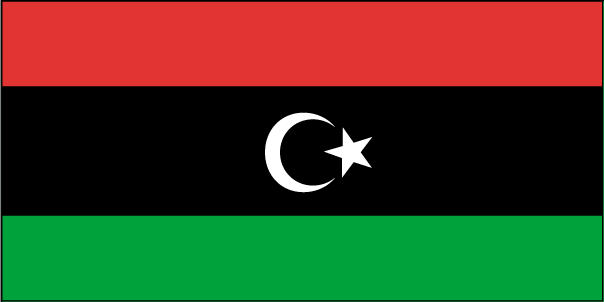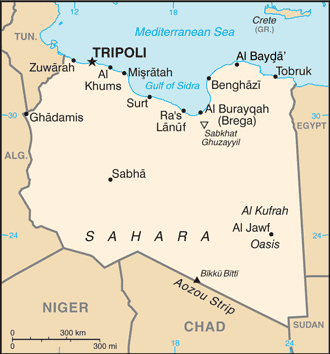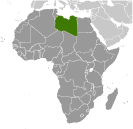
|
|
Advertisements:
EconomyEconomy - overview
The Libyan economy depends primarily upon revenue from hydrocarbons, which contribute about 95% of export earnings, 65% of GDP, and 80% of government revenue. Substantial revenue from the energy sector coupled with a small population give Libya one of the highest per capita GDPs in Africa, but little of this income flowed to the lower orders of society. Libya in the past five years made progress on economic reform as part of a broader campaign to reintegrate the country into the international fold. This effort picked up steam after UN sanctions were lifted in September 2003 and after Libya announced in December 2003 that it would abandon programs to build weapons of mass destruction. The process of lifting US unilateral sanctions began in the spring of 2004; all sanctions were removed by June 2006, helping Libya attract greater foreign direct investment, especially in the energy sector. Libyan oil and gas licensing rounds drew high international interest, but new rounds are unlikely until Libya establishes a more permanent government. The National Oil Corporation (NOC) set a goal of nearly doubling oil production to 3 million bbl/day by 2012, but the goal is unlikely to be met by the target date. Libya faces a long road ahead in liberalizing its primarily socialist economy, but the revolution probably increases the opportunity for entrepreneurial activity and the evolution of a more market-based economy. The service and construction sectors, which account for roughly 20% of GDP, expanded over the past five years and could become a larger share of GDP after political volatility subsides. Climatic conditions and poor soils severely limit agricultural output, and Libya imports about 75% of its food. Libya's primary agricultural water source remains the Great Manmade River Project, but significant resources will be needed in desalinization to meet growing water demands. Gdp (purchasing power parity) World Ranking: 101
$37.97 billion (2011 est.)
$97.43 billion (2010 est.) $95.02 billion (2009 est.) Note Data are in 2011 US dollars Gdp (official exchange rate)
$36.87 billion (2011 est.)
Gdp - real growth rate
NA% (2011 est.)
2.5% (2010 est.) -0.1% (2009 est.) Gdp - per capita (ppp) World Ranking: 90
$14,100 (2010 est.)
$14,900 (2010 est.) Note $14,800 (2009 est.) Gdp - composition by sector
Agriculture 3.2%
Industry 49.5% Services 47.3% (2011 est.) Labor force World Ranking: 140
1.16 million (2011 est.)
Labor force - by occupation
Agriculture 17%
Industry 23% Services 59% (2004 est.) Unemployment rate World Ranking: 177
30% (2004 est.)
Population below poverty line
NA
Note About one-third of Libyans live at or below the national poverty line Household income or consumption by percentage share
Lowest 10% NA%
Highest 10% NA% Investment (gross fixed) World Ranking: 150
2.8% of GDP (2011 est.)
Budget
Revenues $18.15 billion
Expenditures $32 billion (2011 est.) Taxes and other revenues World Ranking: 22
49.2% of GDP (2011 est.)
Budget surplus (+) or deficit (-) World Ranking: 212
-37.6% of GDP (2011 est.)
Public debt World Ranking: 143
4.2% of GDP (2011 est.)
3.2% of GDP (2010 est.) Inflation rate (consumer prices) World Ranking: 207
15.9% (2011 est.)
2.5% (2010 est.) Central bank discount rate World Ranking: 102
9.52% (31 December 2010 est.)
3% (31 December 2009 est.) Commercial bank prime lending rate World Ranking: 140
6% (31 December 2011 est.)
6% (31 December 2010 est.) Stock of narrow money World Ranking: 51
$38.49 billion (31 December 2011 est.) $31.95 billion (31 December 2010 est.) Stock of broad money World Ranking: 71
$41.71 billion (31 December 2011 est.) $35.96 billion (31 December 2010 est.) Stock of domestic credit World Ranking: 66
$38.91 billion (31 December 2011 est.) $45.6 billion (31 December 2010 est.) Market value of publicly traded shares
$NA
Agriculture - products
Wheat, barley, olives, dates, citrus, vegetables, peanuts, soybeans; cattle Industries
Petroleum, petrochemicals, aluminum, iron and steel, food processing, textiles, handicrafts, cement Industrial production growth rate World Ranking: 109
2.7% (2010 est.)
Electricity - production World Ranking: 64
26.95 billion kWh (2008 est.)
Electricity - consumption World Ranking: 66
22.89 billion kWh (2008 est.)
Electricity - exports
117 million kWh (2008 est.)
Electricity - imports
48 million kWh (2008 est.)
Oil - production World Ranking: 18
1.789 million bbl/day (2010 est.) Oil - consumption World Ranking: 46
289,000 bbl/day (2010 est.)
Oil - exports World Ranking: 16
1.58 million bbl/day (2010 est.) Oil - imports World Ranking: 197
575.3 bbl/day (2009 est.)
Oil - proved reserves World Ranking: 9
46.42 billion bbl (1 January 2011 est.) Natural gas - production World Ranking: 35
15.9 billion cu m (2009 est.)
Natural gas - consumption World Ranking: 55
6.01 billion cu m (2009 est.)
Natural gas - exports World Ranking: 21
9.89 billion cu m (2009 est.)
Natural gas - imports World Ranking: 88
0 cu m (2011 est.)
Natural gas - proved reserves World Ranking: 22
1.548 trillion cu m (1 January 2011 est.) Current account balance World Ranking: 33
$5.056 billion (2011 est.)
$16.8 billion (2010 est.) Exports World Ranking: 78
$16.46 billion (2011 est.)
$48.94 billion (2010 est.) Exports - commodities
Crude oil, refined petroleum products, natural gas, chemicals Exports - partners
Italy 21.5%, Germany 13.5%, France 13.4%, China 10.1%, Spain 4.9%, Tunisia 4.6%, India 4.3% (2011) Imports World Ranking: 94
$10.32 billion (2011 est.)
$24.56 billion (2010 est.) Imports - commodities
Machinery, semi-finished goods, food, transport equipment, consumer products Imports - partners
Egypt 15.5%, Tunisia 11.9%, Turkey 8.1%, China 7.8%, Italy 7.5%, Syria 4.6%, France 4.4%, Germany 4.3% (2011) Reserves of foreign exchange and gold World Ranking: 23
$100.3 billion (31 December 2011 est.) $99.84 billion (31 December 2010 est.) Debt - external World Ranking: 118
$4.774 billion (31 December 2011 est.) $6.375 billion (31 December 2010 est.) Stock of direct foreign investment - at home World Ranking: 73
$16.13 billion (31 December 2011 est.) $16.04 billion (31 December 2010 est.) Stock of direct foreign investment - abroad World Ranking: 49
$16.78 billion (31 December 2011 est.) $16.64 billion (31 December 2010 est.) Exchange rates
Libyan dinars (LYD) per US dollar - 1.2241 (2011 est.)1.2668 (2010 est.) 1.2535 (2009) 1.2112 (2008) 1.2604 (2007) Fiscal year
Calendar year
Comments
Add a new comment: |
Advertisement
Members area
Libya (Tripoli):
 
GPS points from Libya (Tripoli)
|
||||||||

 The Italians supplanted the Ottoman Turks in the area around Tripoli in 1911 and did not relinquish their hold until 1943 when defeated in World War II. Libya then passed to UN administration and achieved independence in 1951. Following a 1969 military coup, Col. Muammar Abu Minyar al-QADHAFI began to espouse his own political system, the Third Universal Theory. The system was a combination of socialism and Islam derived in part from tribal practices and was supposed to be implemented by the Libyan people themselves in a unique form of "direct democracy." QADHAFI used oil funds during the 1970s and 1980s to promote his ideology outside Libya, supporting subversives and terrorists abroad to hasten the end of Marxism and capitalism. In addition, beginning in 1973, he engaged in military operations in northern Chad's Aozou Strip - to gain access to minerals and to use as a base of influence in Chadian politics - but was forced to retreat in 1987. UN sanctions in 1992 isolated QADHAFI politically following the downing of Pan Am Flight 103 over Lockerbie, Scotland. During the 1990s, QADHAFI began to rebuild his relationships with Europe. UN sanctions were suspended in April 1999 and finally lifted in September 2003 after Libya accepted responsibility for the Lockerbie bombing. In December 2003, Libya announced that it had agreed to reveal and end its programs to develop weapons of mass destruction and to renounce terrorism. QADHAFI subsequently made significant strides in normalizing relations with Western nations. The US rescinded Libya's designation as a state sponsor of terrorism in June 2006. In August 2008, the US and Libya signed a bilateral comprehensive claims settlement agreement to compensate claimants in both countries who allege injury or death at the hands of the other country, including the Lockerbie bombing, the LaBelle disco bombing, and the UTA 772 bombing. In October 2008, the US Government received $1.5 billion pursuant to the agreement to distribute to US national claimants, and as a result effectively normalized its bilateral relationship with Libya. The two countries then exchanged ambassadors for the first time since 1973 in January 2009. Libya in May 2010 was elected to its first three-year seat on the UN Human Rights Council, prompting protests from international non-governmental organizations and human rights campaigners. Unrest that began in several Near Eastern and North African countries in late December 2010 spread to several Libyan cities in early 2011. In March 2011, a Transitional National Council (TNC) was formed in Benghazi with the stated aim of overthrowing the QADHAFI regime and guiding the country to democracy. In response to QADHAFI's harsh military crackdown on protesters, the UN Security Council adopted Resolution 1973, which demanded an immediate ceasefire and authorized the international community to establish a no-fly zone over Libya. After several months of see-saw fighting, anti-QADHAFI forces in August 2011 captured the capital, Tripoli. In mid-September, the UN General Assembly voted to recognize the TNC as the legitimate interim governing body of Libya. The TNC on 23 October officially declared the country liberated following the defeat of the last remaining pro-QADHAFI stronghold and QADHAFI's death, and plans to transition toward elections, the formation of a constitution, and a new government.
The Italians supplanted the Ottoman Turks in the area around Tripoli in 1911 and did not relinquish their hold until 1943 when defeated in World War II. Libya then passed to UN administration and achieved independence in 1951. Following a 1969 military coup, Col. Muammar Abu Minyar al-QADHAFI began to espouse his own political system, the Third Universal Theory. The system was a combination of socialism and Islam derived in part from tribal practices and was supposed to be implemented by the Libyan people themselves in a unique form of "direct democracy." QADHAFI used oil funds during the 1970s and 1980s to promote his ideology outside Libya, supporting subversives and terrorists abroad to hasten the end of Marxism and capitalism. In addition, beginning in 1973, he engaged in military operations in northern Chad's Aozou Strip - to gain access to minerals and to use as a base of influence in Chadian politics - but was forced to retreat in 1987. UN sanctions in 1992 isolated QADHAFI politically following the downing of Pan Am Flight 103 over Lockerbie, Scotland. During the 1990s, QADHAFI began to rebuild his relationships with Europe. UN sanctions were suspended in April 1999 and finally lifted in September 2003 after Libya accepted responsibility for the Lockerbie bombing. In December 2003, Libya announced that it had agreed to reveal and end its programs to develop weapons of mass destruction and to renounce terrorism. QADHAFI subsequently made significant strides in normalizing relations with Western nations. The US rescinded Libya's designation as a state sponsor of terrorism in June 2006. In August 2008, the US and Libya signed a bilateral comprehensive claims settlement agreement to compensate claimants in both countries who allege injury or death at the hands of the other country, including the Lockerbie bombing, the LaBelle disco bombing, and the UTA 772 bombing. In October 2008, the US Government received $1.5 billion pursuant to the agreement to distribute to US national claimants, and as a result effectively normalized its bilateral relationship with Libya. The two countries then exchanged ambassadors for the first time since 1973 in January 2009. Libya in May 2010 was elected to its first three-year seat on the UN Human Rights Council, prompting protests from international non-governmental organizations and human rights campaigners. Unrest that began in several Near Eastern and North African countries in late December 2010 spread to several Libyan cities in early 2011. In March 2011, a Transitional National Council (TNC) was formed in Benghazi with the stated aim of overthrowing the QADHAFI regime and guiding the country to democracy. In response to QADHAFI's harsh military crackdown on protesters, the UN Security Council adopted Resolution 1973, which demanded an immediate ceasefire and authorized the international community to establish a no-fly zone over Libya. After several months of see-saw fighting, anti-QADHAFI forces in August 2011 captured the capital, Tripoli. In mid-September, the UN General Assembly voted to recognize the TNC as the legitimate interim governing body of Libya. The TNC on 23 October officially declared the country liberated following the defeat of the last remaining pro-QADHAFI stronghold and QADHAFI's death, and plans to transition toward elections, the formation of a constitution, and a new government.